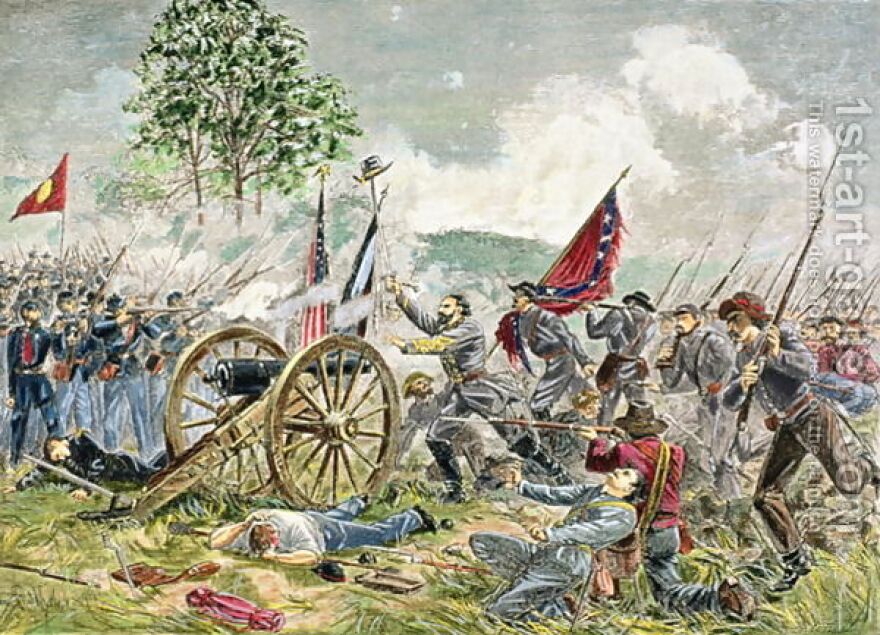Originally aired on November 25, 1994 - In part 13 of our Civil War series, Virginia Tech history professor James Robertson relates the story of two old friends, Lewis Armistead and Winfield Hancock, who crossed paths during the July 3, 1863 battle known as Pickett’s Charge. They were on opposing sides of the conflict.
#13 – Armistead – Hancock
Lewis Armistead was born in 1816 in New Bern, North Carolina. Winfield Scott Hancock was born in 1824 at Montgomery Square, Pennsylvania. Both men attended West Point. Armistead was dismissed from the Academy for breaking a mess plate over the head of Cadet Jubal Early of Virginia. He then enlisted in the Regular Army. Hancock graduated with the West Point Class of 1844.
Armistead and Hancock met during the Mexican War as fellow officers in the 6th U. S. Infantry Regiment. They fought side by side in the battle of Churubusco; they served together in the Florida Everglades campaign against the Seminole Indians; together they made a long, toiling march across the plains and mountains from Fort Leavenworth, Kansas, to Benicia Barracks in California. Army duty and compatibility of spirit made them the closest of friends.
In the spring of 1861, the angry guns of civil war echoed across the land. Southern-born officers everywhere resigned their commissions to head home and cast their lot with their native states. Mrs. Winfield Hancock gave a farewell party for the old 6th Infantry crowd that was breaking apart forever.
The evening was heavy with the sadness of severing friendships. As midnight drew near, Mrs. Albert Sidney Johnston bowed to requests to sing a few songs. Her voice was always beautiful – but especially on that occasion. She closed with an English melody then gaining great popularity in America. It was called “Auld Lang Syne”; and as Mrs. Johnson filled the room with its nostalgic sentiments, Armistead walked over to Hancock. The two men embraced tearfully as they said goodbye.
Hancock came east and rose steadily in rank and esteem with the Union Army of the Potomac. He gained the title “Hancock the Superb” for extraordinary gallantry in action. By 1863, he was a major general commanding the elite II Corps of the North’s premier army.
Armistead first lead the 57th Virginia from the south-side portion of the state. In the spring of 1862, he became a brigadier general and took command of George Pickett’s old Virginia brigade. Armistead was a soldier’s soldier, beloved by superiors and enlisted men alike. The military by then was his life, for he was a widower, and his only son was a member of his staff.
The paths of Armistead and Hancock crossed one more time. On the afternoon of July 3, 1863, on the third day of fighting at Gettysburg, Armistead’s brigade was a centerpiece in a massive Confederate assault known popularly as Pickett’s Charge. The Southerners had to move across a 1,400 yard wheat field, in full view of Union cannon and musketry. Some 7,000 of 12,000 Confederates went down in the hour-long contest.
Armistead and one hundred and fifty of his men actually made it to the Federal position. The little group fought its way over a stone wall, stumbled forward another forty yards, then fell amid a blaze of gunfire.
The North Carolina brigadier clutched a Union cannon as he slid to the ground, mortally wounded. Several Federal soldiers knelt beside him to see what assistance they could offer. Armistead had but one request; he asked that his watch and other personal effects be sent home to his good friend, Winfield Hancock, if anyone knew the whereabouts of the officer.
It was not difficult to find the one-time friend that day, for it was Winfield Hancock’s II Corps that had repulsed Pickett’s Charge; and Hancock took Armistead’s valuables with tears in his eyes as he was being borne seriously injured to a field hospital.
Hancock continued a distinguished career. In 1880 he was the Democratic Party nominee for President of the United States. Hancock lived for twenty three years after the battle of Gettysburg. Whether he ever visited Armistead’s grave in Baltimore, we will never know; but surely he must have thought often of “the good old days” and the close companions – like Lewis Armistead – who had made it so.


